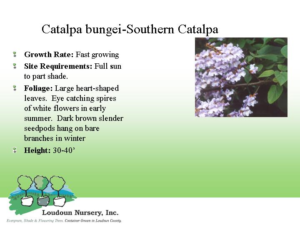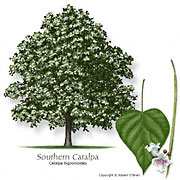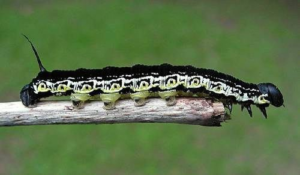
Figure 6 – Southern Catalpa Habitat Description
Retrieved http://library.thinkquest.org/11226/why.htm.

Figure 5 – Southern Catalpa
Retrieved: http://www.loudounnursery.com/downloads/New Directory/Southern Catalpa.jpg.
In general, the major source of energy required by the Catalpa is the Sun and moderate water or moisture; however this could vary in different type of Catalpa species. The Catalpa, like all trees and plants are capable of producing food, through the process of photosynthesis. Therefore, it is recognized as a primary producer in the ecosystem.[i] It provides food for other animals such as Catalpa Sphinx (See Figure 6a) but is also very commonly found in any Catalpa tree when Catalpa Sphinx is at its caterpillar stage. At the caterpillar stage, it feeds on the leaves of Catalpa. Catalpa also uses the light energy to convert carbon dioxide into sugar. After the conversion is complete, the stomata (opening of the leaves) open to let oxygen leave the plant while taking in more carbon dioxide; this process repeats itself until the plant dies.[ii]

Figure 6a – Catalpa Sphinx – Caterpillar stage
Retrieved: http://www.hiltonpond.org/images/CaterpillarCatalpaSphinx01.jpg
Now let’s focus on the two main North American Catalpa trees (Northern Catalpa and Southern Catalpa). Both species could adapt to soil widely, which is one of the reasons why the Catalpa tree’s are able to be found all over the United States and in the southern tips of Canada even though the Catalpa tree is believed to have tropical origin.[iii] Both trees require full sun or partial sun. Although the Catalpa trees grow best in moderate moisture these trees are widely adaptable to different type of moisture conditions.[iv] Both these species are closely related. All Catalpa species are known for their visually pleasing flowers. The Southern Catalpa in its natural habitat prefers moist soil and full sun. On the other hand, this tree can also be easily raised by planting seeds. As a result, it could also be found in many park and gardens in all the temperate countries.[v] The Northern Catalpa tree prefers moist, full sun and soils that contain high PH. Despite this fact, they are still able to survive in many places. For example, this tree can also be found east of the Rocky Mountains, which is well beyond their own natural native habitat. The Catalpa tree can withstand wet conditions, dry alkaline conditions, and extremely hot, dry, environments.[vi] However, the optimal habitats for Catalpa’s include good amounts of moisture with the PH of the soil generally around 5.5 to 7. This means that the PH of the soil is acidic. Furthermore, in places in the North where the climate is colder and when the first frost occurs all the leaves fall of the Catalpa tree. This shows that the leaves are not built to withstand the cold but these trees can still survive the winter as long as the minimum non frost days are 90 days.[vii]
[i] Stephenson A G. 1982. The role of Extrafloral Nectaries of Catalpa Speciosa in limiting herbivores and increasing fruit production [Internet]. [Cited 2008, October 25, 2008] (63) 3. 663-669. Available from http://www.jstor.org/stable/1936786?&Search=yes&term=Catalpa&list=hide&searchUri=%2Faction%2FdoBasicSearch%3FQuery%3DCatalpa%26wc%3Don%26dc%3DAll%2BDisciplines&item=1&ttl=1770&returnArticleService=showArticle.
[ii] Waldbauer G. 2003. What good are bugs?: Insects in the web of life. Cambridge. Harvard University Press. 82 – 86.
[iii] Vines R. A. 2004. Trees, shrubs and woody vines of the southwest. Austin: University of Texas Press. P. 926-927.
[iv] ______. Nature`s Hill Nursey. 2008. Southern Catalpa [Înternet] [Cited 2008, October 23, 2008] Available from. http://www.naturehills.com/product/southern_catalpa.aspx
[v] _______. Nature`s Hill Nursey. 2008. Southern Catalpa [Înternet] [Cited 2008, October 23, 2008] Available from. http://www.naturehills.com/product/southern_catalpa.aspx
[vi] _______. Nature`s Hill Nursey. 2008. Southern Catalpa [Înternet] [Cited 2008, October 23, 2008]. Available from http://www.naturehills.com/product/northern_catalpa.aspx
[vii] _______. Nature`s Hill Nursey. 2008. Southern Catalpa [Înternet] [Cited 2008, October 23, 2008]. Available from http://www.naturehills.com/product/northern_catalpa.aspx






Recent Comments